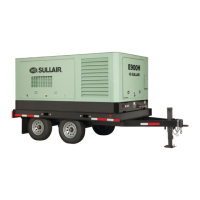Section 1
E900H User Manual 1: Safety
02250203-986 R03
Subject to EAR, ECCN EAR99 and related export control restrictions. 1
Safety
1.1 General
Sullair designs and manufactures all of its products so
they can be operated safely. However, the responsibility
for safe operation rests with those who use and maintain
these products. The following safety precautions are
offered as a guide which, if conscientiously followed, will
minimize the possibility of accidents throughout the
useful life of this equipment. Read the AEM Safety
Manual prior to compressor operation and towing, if
applicable in your area.
The air compressor should be operated only by those
who
have been trained and delegated to do so, and who
have read and understood this Operator’s Manual.
Failure to follow the instructions, procedures and safety
precautions in this manual can result in accidents and
injuries.
NEVER
start the air compressor unless it is safe to do so.
DO NOT attempt to operate the air compressor with a
known unsafe condition. Tag the air compressor and
render it inoperative by disconnecting and locking out all
power at source or otherwise disabling its prime mover
so others who may not know of the unsafe condition
cannot attempt to operate it until the condition is
corrected.
Use and operate the air compressor only in full
co
mpliance with all pertinent OSHA requirements and/or
all pertinent Federal, State and Local codes or
requirements.
DO NOT
modify the compressor except with written
factory approval.
Each day, walk around the air compressor and inspect
for
leaks, loose or missing parts, damaged parts or parts
out of adjustment. Perform all recommended daily
maintenance.
Inspect for torn, frayed, blistered or otherwise
de
teriorated and degraded hoses. Replace as required.
1.2 Personal protective equipment
A. Prior to installing or operating the compressor, own-
ers, employers and users should become familiar
with, and comply with, all applicable OSHA regula-
tions and/or any applicable Federal, State and Local
codes, standards, and regulations relative to per-
sonal protective equipment, such as eye and face
protective equipment, respiratory protective equip-
ment, equipment intended to protect the extremities,
protective clothing, protective shields and barriers
and electrical protective equipment, as well as noise
exposure administrative and/or engineering controls
and/or personal hearing protective equipment.
1.3 Pressure release
A. Open the pressure relief valve at least weekly to
make sure it is not blocked, closed, obstructed or
otherwise disabled.
B. Install an appropriate flow-limiting valve between the
compressor service air outlet and the shutoff (throt-
tle) valve, when an air hose exceeding 1/2″ (13 mm)
inside diameter is to be connected to the shutoff
(throttle) valve, to reduce pressure in case of hose
failure, per OSHA Standard 29 CFR 1926.302 (b) (7)
or any applicable Federal, State and Local codes,
standards and regulations.
C. When the hose is to be used to supply a manifold,
install an additional appropriate flow-limiting valve
between the manifold and each air hose exceeding
1/2″ (13 mm) inside diameter that is to be connected
to the manifold to reduce pressure in case of hose
failure.
NOTE
Operator is required to read
entire instruction manual.

